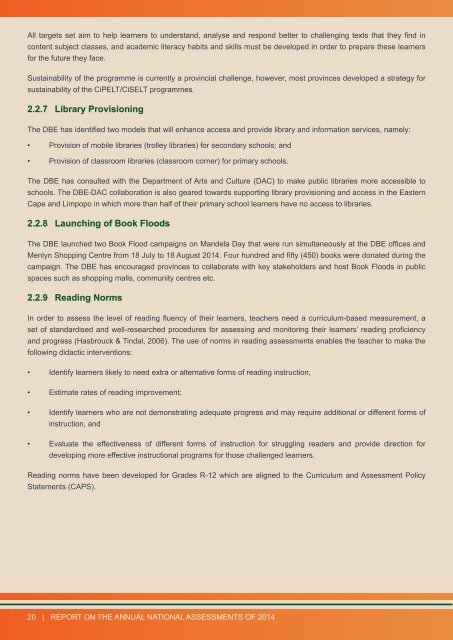REPORT ON THE ANA OF 2014
REPORT ON THE ANA OF 2014
REPORT ON THE ANA OF 2014
- No tags were found...
You also want an ePaper? Increase the reach of your titles
YUMPU automatically turns print PDFs into web optimized ePapers that Google loves.
All targets set aim to help learners to understand, analyse and respond better to challenging texts that they find incontent subject classes, and academic literacy habits and skills must be developed in order to prepare these learnersfor the future they face.Sustainability of the programme is currently a provincial challenge, however, most provinces developed a strategy forsustainability of the CiPELT/CiSELT programmes.2.2.7 Library ProvisioningThe DBE has identified two models that will enhance access and provide library and information services, namely:• Provision of mobile libraries (trolley libraries) for secondary schools; and• Provision of classroom libraries (classroom corner) for primary schools.The DBE has consulted with the Department of Arts and Culture (DAC) to make public libraries more accessible toschools. The DBE-DAC collaboration is also geared towards supporting library provisioning and access in the EasternCape and Limpopo in which more than half of their primary school learners have no access to libraries.2.2.8 Launching of Book FloodsThe DBE launched two Book Flood campaigns on Mandela Day that were run simultaneously at the DBE offices andMenlyn Shopping Centre from 18 July to 18 August <strong>2014</strong>. Four hundred and fifty (450) books were donated during thecampaign. The DBE has encouraged provinces to collaborate with key stakeholders and host Book Floods in publicspaces such as shopping malls, community centres etc.2.2.9 Reading NormsIn order to assess the level of reading fluency of their learners, teachers need a curriculum-based measurement, aset of standardised and well-researched procedures for assessing and monitoring their learners’ reading proficiencyand progress (Hasbrouck & Tindal, 2006). The use of norms in reading assessments enables the teacher to make thefollowing didactic interventions:• Identify learners likely to need extra or alternative forms of reading instruction;• Estimate rates of reading improvement;• Identify learners who are not demonstrating adequate progress and may require additional or different forms ofinstruction, and• Evaluate the effectiveness of different forms of instruction for struggling readers and provide direction fordeveloping more effective instructional programs for those challenged learners.Reading norms have been developed for Grades R-12 which are aligned to the Curriculum and Assessment PolicyStatements (CAPS).20 | <strong>REPORT</strong> <strong>ON</strong> <strong>THE</strong> ANNUAL NATI<strong>ON</strong>AL ASSESSMENTS <strong>OF</strong> <strong>2014</strong>


